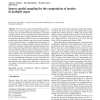Free Online Productivity Tools
i2Speak
i2Symbol
i2OCR
iTex2Img
iWeb2Print
iWeb2Shot
i2Type
iPdf2Split
iPdf2Merge
i2Bopomofo
i2Arabic
i2Style
i2Image
i2PDF
iLatex2Rtf
Sci2ools
BC
2006
2006
Sparse Spatial Sampling for the Computation of Motion in Multiple Stages
The avian retino-tecto-rotundal pathway plays a central role in motion analysis and features complex connectivity. Yet, the relation between the pathway's structural arrangement and motion computation has remained elusive. For an important type of tectal wide-field neuron, the stratum griseum centrale type I (SGC-I) neuron, we quantified its structure and found a spatially sparse but extensive sampling of the retinal projection. A computational investigation revealed that these structural properties enhance the neuron's sensitivity to change, a behaviorally important stimulus attribute, while preserving information about the stimulus location in the SGC-I population activity. Furthermore, the SGC-I neurons project with an interdigitating topography to the nucleus rotundus, where the direction of motion is computed. We showed that, for accurate direction-of-motion estimation, the interdigitating projection of tectal wide-field neurons requires a two-stage rotundal algorithm, w...
Avian Retino-tecto-rotundal Pathway | BC 2006 | Important Stimulus Attribute | Tectal Wide-field Neurons |
| Added | 10 Dec 2010 |
| Updated | 10 Dec 2010 |
| Type | Journal |
| Year | 2006 |
| Where | BC |
| Authors | Alireza S. Mahani, Reza Khanbabaie, Harald Luksch, Ralf Wessel |
Comments (0)

